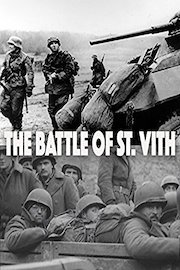-
Genres
-
CastRobert Taylor
-
DirectorArmy Pictorial Center
-
Release Date1965
-
Runtime57 min

The Battle of St. Vith is a 1963 war film set during the Battle of the Bulge in World War II. Directed by John Peyser and starring Robert Taylor, the film tells the story of the desperate struggle to hold the small Belgian town of St. Vith against the overwhelming assault of German forces. The film opens with a detailed overview of the historical background of the battle, including the German offensive that caught the Allies off guard and led to the brutal fighting around St. Vith. The town, situated at a key crossroads, was a vital strategic position for the Allies, and the German troops were determined to seize it at any cost.
Robert Taylor plays General Bruce C. Clarke, the commander of the American troops in St. Vith. Taylor gives a powerful performance as a tough, decisive leader who is determined to hold the town and its surrounding areas against the Nazi onslaught. Clarke is supported by a small but valiant group of soldiers, including Lt. Col. Joe Clemons (played by actor James Whitmore), who is sent on a dangerous mission to blow up a vital bridge that is key to the German supply lines.
As the Germans close in, Clarke and his men are forced to fight a desperate and grueling battle against overwhelming odds. The film provides a detailed and realistic portrayal of the brutal tactics used by both sides, including the use of tanks, artillery, and devastating airstrikes. The intense battle scenes are expertly directed and choreographed, making extensive use of real-life footage of the actual battle.
One of the strengths of the film is its attention to detail in depicting both the heroism and the tragedy of war. Many of the characters are based on real-life individuals, and the film gives a sense of the personal sacrifices and emotional turmoil of the men who fought and died in the battle. The film also explores the psychological effects of combat, such as the fear, exhaustion, and camaraderie that mark the experience of soldiers under fire.
Despite the grim subject matter, the film also features moments of humor and camaraderie among the troops. In one memorable scene, a group of soldiers take refuge in a farmhouse and share a meal with the grateful Belgian family who live there. The scene provides a respite from the violence of the battle and highlights the humanity of the soldiers and civilians caught up in the conflict.
Throughout the film, the performance of Robert Taylor anchors the action, providing a commanding and nuanced portrayal of a leader under pressure. Taylor convincingly conveys the moral and emotional weight of his character's responsibilities, as well as the toll taken by the escalating violence of the battle.
Overall, The Battle of St. Vith is a gripping and engaging war film that provides a detailed and realistic portrayal of one of the most pivotal battles of World War II. With a strong cast, a powerful script, and expert direction, the film is a testament to the heroism and sacrifice of the men who fought in the battle, and a tribute to the enduring human spirit in the face of overwhelming adversity.
The Battle of St. Vith is a 1965 action movie with a runtime of 57 minutes.